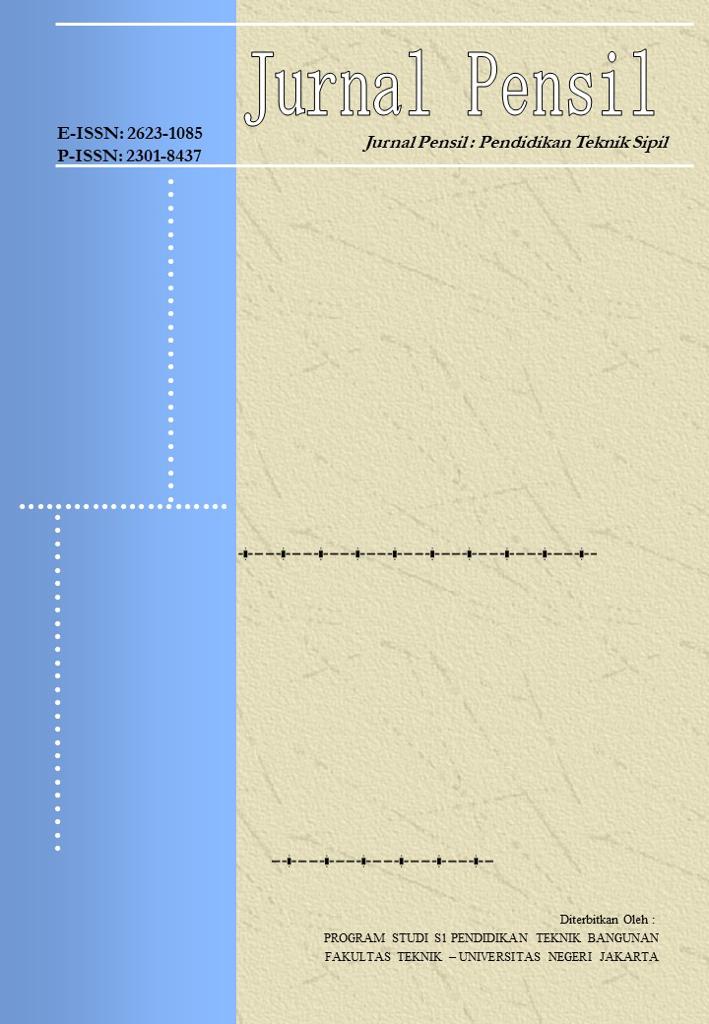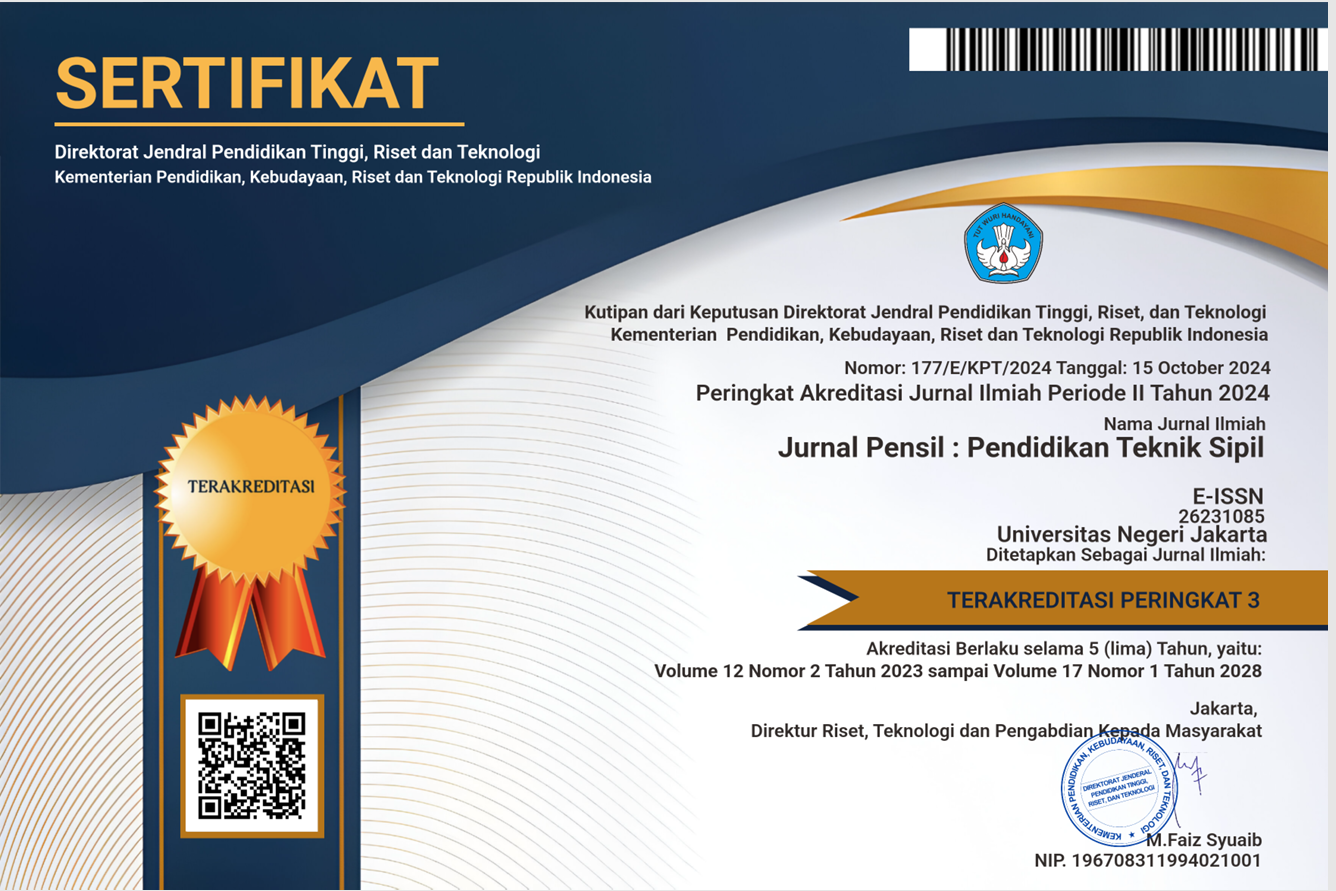PERFORMANCE OF MASONRY BRICK WITH CALCIUM HYDROXIDE AS MORTAR
DOI:
https://doi.org/10.21009/jpensil.v12i3.37905Keywords:
Masonry, Calcium Hydoroxide, Experiment TestAbstract
This study aims to determine the shear strength and flexural strength of red brick masonry, determine the effective thickness of calcium hydroxide mortar with a mixture ratio of 1Kp:2Ps, and determine the failure pattern of red brick masonry due to the load received during the direct shear strength test and flexural strength test. The research was conducted by experimental method. The tests carried out were the direct shear and flexural strength tests. Variation of successive mortar thickness of 10mm, 15mm, and 20mm. The test object is 18 (eighteen), the thickness variation consists of 3 test objects. Data analysis used descriptive quantitative by finding the average value of the shear strength and flexural strength. Based on the test results, the average compressive strength and splitting tensile strength of the mortar were 0.613 MPa, 0.0414 MPa. The average shear strength with a 10mm; 15mm; and 20mm is 0.025 MPa; 0.020 MPa; and 0.016 MPa, respectively. The flexural strength of mortar thickness with 10mm, 15mm, and 20mm are 0.034 MPa; 0.045 MPa; and 0.041 MPa, , respectively. In the masonry shear test, the effective thickness of the mortar was found at 10mm with a maximum shear strength of 0.025 MPa, while in the flexural test, the effective thickness of the mortar was found at a thickness of 15mm with 0.045 MPa. The pattern of failure in red masonry's shear strength and flexural strength tests is the mortar failure.
References
Aldabagh, I. S., Abed, J. M., Khaleel, B. A., & Hamah Sor, N. (2022). Influence of water quality and slag on the development of mechanical properties of self compacting mortar. Materials Today: Proceedings, 57, 892–897. https://doi.org/10.1016/J.MATPR.2022.02.575
Alecci, V., Fagone, M., Rotunno, T., & De Stefano, M. (2013). Shear strength of brick masonry walls assembled with different types of mortar. Construction and Building Materials, 40, 1038–1045. https://doi.org/10.1016/J.CONBUILDMAT.2012.11.107
Alvarez, J. I., Veiga, R., Martínez-Ramírez, S., Secco, M., Faria, P., Maravelaki, P. N., Ramesh, M., Papayianni, I., & Válek, J. (2021). RILEM TC 277-LHS report: a review on the mechanisms of setting and hardening of lime-based binding systems. Materials and Structures 2021 54:2, 54(2), 1–30. https://doi.org/10.1617/S11527-021-01648-3
Arioglu, N., & Acun, S. (2006). A research about a method for restoration of traditional lime mortars and plasters: A staging system approach. Building and Environment, 41(9), 1223–1230. https://doi.org/10.1016/J.BUILDENV.2005.05.015
Binda, L., Papayianni, I., Toumbakari, E., & Van Hees, R. (n.d.). 2.4 MECHANICAL TESTS ON MORTARS AND ASSEMBLAGES.
Bompa, D. V., & Elghazouli, A. Y. (2020). Compressive behaviour of fired-clay brick and lime mortar masonry components in dry and wet conditions. Materials and Structures/Materiaux et Constructions, 53(3), 1–21. https://doi.org/10.1617/S11527-020-01493-W/FIGURES/10
Bülbül Bahtiyar, T., & Dişli, G. (2022). Risk management and preventive conservation of historic buildings: The case of Karatay Madrasah (Museum). International Journal of Disaster Risk Reduction, 77, 103079. https://doi.org/10.1016/J.IJDRR.2022.103079
Chase, G. W. (1983). Characterization of the interface between brick and mortar.
D’Alpaos, C., & Valluzzi, M. R. (2020). Protection of Cultural Heritage Buildings and Artistic Assets from Seismic Hazard: A Hierarchical Approach. Sustainability 2020, Vol. 12, Page 1608, 12(4), 1608. https://doi.org/10.3390/SU12041608
Demiral, N. C., Ozkan Ekinci, M., Sahin, O., Ilcan, H., Kul, A., Yildirim, G., & Sahmaran, M. (2022). Mechanical anisotropy evaluation and bonding properties of 3D-printable construction and demolition waste-based geopolymer mortars. Cement and Concrete Composites, 134, 104814. https://doi.org/10.1016/J.CEMCONCOMP.2022.104814
Elghazouli, A. Y., Bompa, D. V., Mourad, S. A., & Elyamani, A. (2021). In-plane lateral cyclic behaviour of lime-mortar and clay-brick masonry walls in dry and wet conditions. Bulletin of Earthquake Engineering, 19(13), 5525–5563. https://doi.org/10.1007/S10518-021-01170-5/FIGURES/14
Fitri, I., Ahmad, Y., & Ahmad, F. (2015). Conservation of Tangible Cultural Heritage in Indonesia: A Review Current National Criteria for Assessing Heritage Value. Procedia - Social and Behavioral Sciences, 184, 71–78. https://doi.org/10.1016/J.SBSPRO.2015.05.055
Forster, A. M., & Scottish Lime Centre Trust. (2004). How hydraulic lime binders work : hydraulicity for beginners and the hydraulic lime family.
Gil, L. (2016). A comprehensive test procedure for determination of shear strength parameters of brick masonry specimens.
Hajj, R., & Bhasin, A. (2018). The search for a measure of fatigue cracking in asphalt binders–a review of different approaches. International Journal of Pavement Engineering, 19(3), 205–219. https://doi.org/10.1080/10298436.2017.1279490
Istegun, B., & Celebi, E. (2018). Triplet shear tests on masonry units with and without seismic textile reinforcement. Lecture Notes in Civil Engineering, 7, 427–435. https://doi.org/10.1007/978-3-319-64349-6_34/COVER
Jiang, W., Yuan, D., Zhang, S., Bao, R., Xiao, J., Wu, W., & Wang, T. (2023). Experimental analysis of deformation-adapted binders and their mixture performance. Construction and Building Materials, 389, 131733. https://doi.org/10.1016/J.CONBUILDMAT.2023.131733
Karatasios, I., Kilikoglou, V., Theoulakis, P., Colston, B., & Watt, D. (2008). Sulphate resistance of lime-based barium mortars. Cement and Concrete Composites, 30(9), 815–821. https://doi.org/10.1016/J.CEMCONCOMP.2008.06.010
Lanas, J., Bernal, J. L. P., Bello, M. A., & Galindo, J. I. A. (2004). Mechanical properties of natural hydraulic lime-based mortars. Cement and Concrete Research, 34(12), 2191–2201. https://doi.org/10.1016/J.CEMCONRES.2004.02.005
Lumantarna, R., Biggs, D. T., & Ingham, J. M. (2012). Compressive, Flexural Bond, and Shear Bond Strengths of In Situ New Zealand Unreinforced Clay Brick Masonry Constructed Using Lime Mortar between the 1880s and 1940s. Journal of Materials in Civil Engineering, 26(4), 559–566. https://doi.org/10.1061/(ASCE)MT.1943-5533.0000685
Mashari, Hieu, L. H. T., & Tedjosaputro, L. (2021). Conservation of historical cultural buildings in Indonesia and Vietnam. AIP Conference Proceedings, 2406. https://doi.org/10.1063/5.0067288
Mekonnen, H., Bires, Z., & Berhanu, K. (2022). Practices and challenges of cultural heritage conservation in historical and religious heritage sites: evidence from North Shoa Zone, Amhara Region, Ethiopia. Heritage Science, 10(1), 1–22. https://doi.org/10.1186/S40494-022-00802-6/TABLES/11
Murty, C. V. . (2005). IITK-BMTPC earthquake tips : learning earthquake design and construction.
Mydin, M. A. O. (2017). Preliminary studies on the development of lime-based mortar with added egg white. International Journal of Technology, 8(5), 800–810. https://doi.org/10.14716/IJTECH.V8I5.442
Nugroho, M. S., Ma’arif, F., Widodo, S., Rachmi, D. P., Fajriani, R., Suryadwanti, N., & Setiawan, W. (2022). The Effect of Mortar Mixture Variations on the Compressive Strength and Ultrasonic Pulse Velocity. INERSIA Lnformasi Dan Ekspose Hasil Riset Teknik Sipil Dan Arsitektur, 18(2), 225–234. https://doi.org/10.21831/INERSIA.V18I2.55256
Pacheco-Torgal, F., Faria, J., & Jalali, S. (2012). Some considerations about the use of lime-cement mortars for building conservation purposes in Portugal: A reprehensible option or a lesser evil? Construction and Building Materials, 30, 488–494. https://doi.org/10.1016/J.CONBUILDMAT.2011.12.003
Parracha, J. L., Silva, A. S., Cotrim, M., & Faria, P. (2020). Mineralogical and microstructural characterisation of rammed earth and earthen mortars from 12th century Paderne Castle. Journal of Cultural Heritage, 42, 226–239. https://doi.org/10.1016/J.CULHER.2019.07.021
Pozo-Antonio, J. S. (2015). Evolution of mechanical properties and drying shrinkage in lime-based and lime cement-based mortars with pure limestone aggregate. Construction and Building Materials, 77, 472–478. https://doi.org/10.1016/J.CONBUILDMAT.2014.12.115
Prabowo, W., & Karsono, D. (2020). Degradation of Cultural Heritage Buildings. PROCEEDING INTERNATIONAL CONFERENCE ON ENGINEERING, 1(1), 32–41. https://doi.org/10.36728/ICONE.V1I1.1268
Rahardjo, S. (2013). BEBERAPA PERMASALAHAN PELESTARIAN KAWASAN CAGAR BUDAYA DAN STRATEGI SOLUSINYA. Jurnal Konservasi Cagar Budaya, 7(2), 4–17.
Reza Nadi Abiz, M., Reza Esfahani, M., Tanhadoust, A., Nehdi, M. L., & Mohammad Banijamali, S. (2023). Magnesium nanoparticle modified cement-based composites: Performance and compatibility in repair applications. Construction and Building Materials, 400, 132781. https://doi.org/10.1016/J.CONBUILDMAT.2023.132781
Rinandi, N., & Suryaningsih, F. (2015). Inventory of forts in Indonesia. ISPRS Annals of the Photogrammetry, Remote Sensing and Spatial Information Sciences, 2(5W3), 263–270. https://doi.org/10.5194/ISPRSANNALS-II-5-W3-263-2015
Riyanto, E., Widyananto, E., & Renaldy, R. R. (2021). Analisis Kuat Tekan Mortar Geopolimer Berbahan Silica Fume dan Kapur Tohor. INERSIA Lnformasi Dan Ekspose Hasil Riset Teknik Sipil Dan Arsitektur, 17(1), 19–26. https://doi.org/10.21831/INERSIA.V17I1.35901
Safiera et al. (2016). Conservation of Historical Architecture in Malioboro Street, Yogyakarta City, Indonesia. https://doi.org/10.1016/j.sbspro.2016.06.025
Santoso, A., Darmono, D., Ma’arif, F., & H, S. (2017). STUDI PERBANDINGAN RANCANG CAMPUR BETON NORMAL MENURUT SNI 03-2834-2000 DAN SNI 7656:2012. INERSIA Lnformasi Dan Ekspose Hasil Riset Teknik Sipil Dan Arsitektur, 13(2), 105–115. https://doi.org/10.21831/INERSIA.V13I2.17174
Sathiparan, N., Sakurai, K., Numada, M., & Meguro, K. (2013). Experimental investigation on the seismic performance of PP-band strengthening stone masonry houses. Bulletin of Earthquake Engineering, 11(6), 2177–2196. https://doi.org/10.1007/S10518-013-9502-Z/METRICS
Sinka M et al. (2015). Hemp Thermal Insulation Concrete with Alternative Binders, Analysis of their Thermal and Mechanical Properties. https://doi.org/10.1088/1757-899X/96/1/012029
SNI-03-4164. (1996). Metode pengujian kuat tekan dinding pasangan bata merah di laboratorium. Badan Standarisasi Nasional.
SNI 03-1970. (1990). Metode Pengujian Berat Jenis Agregat Halus. Bandung: Badan Standarisasi Indonesia, 1–17.
SNI 03-6825. (2002). Sni 03-6825-2002. Standar Nasional Indonesia Metode Pengujian Kekuatan Tekan Mortar Semen Portland Untuk Pekerjaan Sipil.
SNI 4154. (2014). SNI 4154:2014 Metode Uji Kekuatan Lentur Beton (Menggunakan Balok Sederhana dengan Beban Terpusat di Tengah Bentang) =Standard Test Methods For Flexural Strength Of Concrete (Using Simple Beam With Center-Point Loading).
Swastikawati, A. P. D. ; R. K. (2022). Rekonstruksi mortar tradisional untuk pemugaran benteng nusantara tahap II : Pengaruh waktu perendaman kapur dan komposisi terhadap karakteristik mortar. Balai Konservasi Borobudur.
Válek, J., Hughes, J. J., Pique, F., Gulotta, D., van Hees, R., & Papayiani, I. (2019). Recommendation of RILEM TC 243-SGM: functional requirements for surface repair mortars for historic buildings. Materials and Structures/Materiaux et Constructions, 52(1), 1–18. https://doi.org/10.1617/S11527-018-1284-Y/FIGURES/12
Widiantoro, C., & Ma’arif, F. (2014). EFEK VARIASI FAKTOR AIR SEMEN TERHADAP KUAT GESER PASANGAN DAN POLA KERUSAKKAN GESER PASANGAN BETON RINGAN AERASI MENGGUNAKAN THIN BED MORTAR. INERSIA Lnformasi Dan Ekspose Hasil Riset Teknik Sipil Dan Arsitektur, 10(2). https://doi.org/10.21831/INERSIA.V10I2.9958
Zdeb, T., Tracz, T., & Adamczyk, M. (2022). Physical, mechanical properties and durability of cement mortars containing fly ash from the sewage sludge incineration process. Journal of Cleaner Production, 345, 131055. https://doi.org/10.1016/J.JCLEPRO.2022.131055
Zhang, X., Chiu, Y. wen, Hao, H., & Cui, J. (2021). Free water effect on the dynamic compressive properties of mortar. Cement and Concrete Composites, 118, 103933. https://doi.org/10.1016/J.CEMCONCOMP.2021.103933
Zhang, X., Wang, X., Wan, C., Yang, B., Tang, Z., & Li, W. (2023). Performance evaluation of asphalt binder and mixture modified by pre-treated crumb rubber. Construction and Building Materials, 362, 129777. https://doi.org/10.1016/J.CONBUILDMAT.2022.129777
Zhang, Y., Sang, G., Du, X., Cui, X., Zhang, L., Zhu, Y., & Guo, T. (2021). Development of a novel alkali-activated slag-based composite containing paraffin/ceramsite shape stabilized phase change material for thermal energy storage. Construction and Building Materials, 304, 124594. https://doi.org/10.1016/j.conbuildmat.2021.124594











.png)
.png)
1.png)

